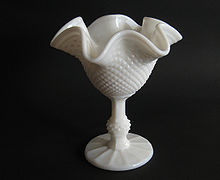Milk glass

Milk glass is an opaque or translucent, milk white or colored glass that can be blown or pressed into a wide variety of shapes. First made in Venice in the 16th century, colors include blue, pink, yellow, brown, black, and white.
Principle
[edit]
Milk glass contains dispersion particles with a refractive index significantly different from the glass matrix which scatters light by the Tyndall scattering effect. The size, distribution, and density of the particles controls the overall effect; which may range from mild opalization to opaque white. Some glasses are somewhat more blue from the side and somewhat red-orange in pass-through light.
The particles are produced by the addition of opacifiers to the molten glass. Some opacifiers can be insoluble and are only dispersed in the melt. Others are added as precursors and react in the melt or dissolve in the molten glass and then precipitate as crystals upon cooling. This is similar to color production in striking glasses though the particles are much bigger.
A variety of opacifiers can be used: bone ash, tin dioxide, arsenic, and antimony compounds. These are also added to ceramic glazes which, chemically; be considered a specific kind of milk glass.
History
[edit]
Milk glass was first made in Venice in the 16th century (lattimo) as a translucent competitor for porcelain. Colors include blue, pink, yellow, brown, black, and white. Some 19th-century glass makers called milky white opaque glass "opal glass". The name milk glass is relatively recent.[2] [3]
Made into decorative dinnerware, lamps, vases, and costume jewellery, milk glass was highly popular during the fin de siècle. Pieces made for the wealthy of the Gilded Age are known for their strikingly delicate beauty in both color and design while Depression glass pieces of the 1930s and 1940s are less so.

Milk glass is often used for architectural decoration when one of the underlying purposes is the display of graphic information. The original milk glass marquee of the Chicago Theatre has been donated to the Smithsonian Institution.[4] A famous use of milk glass is for the four faces of the information booth clock at Grand Central Terminal in New York City. Barbetta, the New York Italian restaurant founded in 1906 and still in business as of 2022,[5] has what is said to be the last opal glass sign in the city.[6]
Collectible
[edit]Milk glass has a considerable following of collectors.[7] Glass makers continue to produce both original pieces and reproductions of popular collectible pieces and patterns.[8]
Notable U.S. manufacturers
[edit]
- Dithridge & Company
- Fenton Glass Company
- Fostoria Glass Company
- Imperial Glass Company
- Kanawha Glass Co.
- L.E. Smith Glass Company[9]
- Mosser Glass
- Thai Soojung Glass Company Limited[10]
- Westmoreland Glass Company
See also
[edit]References
[edit]- ^ "Blue & red - Causes of Color". www.webexhibits.org.
- ^ Husfloen, Kyle (2007). Antique Trader Antiques & Collectibles 2008 Price Guide (illustrated ed.). 644: Krause Publications. p. 1066. ISBN 9780896895317.
((cite book)): CS1 maint: location (link) - ^ Lyon, Joshua. "The Collector's Guide To Milk Glass". Elle Decor. Hearst Digital Media. Retrieved 31 August 2022.
- ^ "1986: The Chicago Theater Reopens". Chicago Public Library. February 2006. Archived from the original on February 12, 2008. Retrieved May 7, 2007.
- ^ "Barbetta".
- ^ Besonen, Julie (2 February 2018). "The Elegant Relic of Restaurant Row". The New York Times.
- ^ Belknap, Eugene McCamly (1949). Milk glass. Crown Publishers. p. 327. ISBN 9780517097403.
- ^ Chiarenza, Frank; James Slater (2007). The Milk Glass Book. A Schiffer book for collectors (illustrated ed.). Schiffer Pub Ltd. p. 228. ISBN 9780764306617.
- ^ Felt, Tom (2007). L.E. Smith Glass Company - The First 100 Years. Collector Books. pp. multiple. ISBN 978-1-60460-969-1.
- ^ Thai Soojung Glass Company Limited
External links
[edit]- National Milk Glass Collectors Society
- National Westmoreland Glass Collectors Club
- Primary processing of Murano Glass
- Basic Overview on Milk Glass
Text is available under the CC BY-SA 4.0 license; additional terms may apply.
Images, videos and audio are available under their respective licenses.
